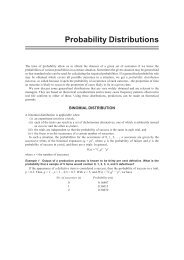International-Business-Dr-R-Chandran-E-book
International-Business-Dr-R-Chandran-E-book
International-Business-Dr-R-Chandran-E-book
You also want an ePaper? Increase the reach of your titles
YUMPU automatically turns print PDFs into web optimized ePapers that Google loves.
225<br />
<strong>International</strong> <strong>Business</strong>- <strong>Dr</strong>. R. <strong>Chandran</strong><br />
production of X by using all the available labour, which country B should<br />
devote its labour for the production of commodity Y.<br />
In China one unit of labour produce three soft toys per day, whereas, in<br />
India, one unit of labour can produce only 1.5 soft toys per day, At the same<br />
time one unit of labour in India cuts and polishes 10 carats of diamond a day<br />
whereas in China it is possible to achieve only 6 six carats a day with the<br />
same amount of labour.<br />
In the above example the main factor is labour, In today’s era of<br />
inventions and innovations, automation, outsourcing and cost reduction, and<br />
mass production, the theory of absolute advantages does not have much<br />
relevance.<br />
The major drawback of the theory of absolute advantage is that it fails to<br />
explain the fact that even less developed countries, which have no real<br />
absolute advantage in any commodity are engaged in the export of goods.<br />
The limitations and shortcomings of this theory are given below:<br />
1. It has not advocated quality, premium and brand aspects of a product.<br />
2. It has restricted itself only to considering the maximum to labour force.<br />
3. It has failed to take into account the fact that many cost reduction<br />
techniques are adopted in mass production.<br />
4. There are many duties applicable when goods enter into other countries,<br />
which have not been accounted for.<br />
5. The nature of the commodity may incur huge transportation costs, which<br />
may be even greater than the cost of the labour.<br />
The theory of international trade, based on absolute cost difference is not<br />
fully applicable in the current century, although it was an acceptable concept<br />
during the period when industrialization was catching up in Europe during<br />
the time of Adam Smith. Another theory, the theory of comparative cost<br />
advantage was therefore evolved as the basis for international trade.<br />
THE THEORY OF COMPARATIVE COST ADVANTAGE<br />
It was David Ricardo, one of the prominent classical economists, who<br />
propounded the theory of comparative cost advantage or the theory of<br />
comparative advantage. He argued that it was the comparative difference in<br />
cost that led to trade between two nations. According to him, each country<br />
would specialize in the production of a commodity in which it has a<br />
comparative advantage in cost. The country should export these<br />
Only for Private Circulation





